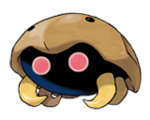Kabuto

| |||
| The Shellfish Pokémon | |||
| #140 - Kabuto | |||
| Evolve | Kabutops | ||
| Debut | Pokémon: Red Version Pokémon: Green Version | ||
| Species Info | |||
| Type | |||
| Height | 0.5 m (1'08") | ||
| Weight | 11.5 kg (25.4 lbs.) | ||
| Color | Brown | ||
| Gender Ratio | 7♂ : 1♀ | ||
| Ability | Swift Swim / Battle Armor | ||
| Hidden Ability | Weak Armor | ||
| Egg Group | Water 1 / Water 3 | ||
| Icon | Sprite | ||
| File:140sprite.png | |||
| Footprint | |||
| 30px | |||
| Base Statistics | |||
| Hit Points | 30 | Speed | 55 |
| Attack | 80 | Sp. Attack | 55 |
| Defense | 90 | Sp. Defense | 45 |
| Training Info | |||
| Catch Rate | 045 | Hatch Steps | 7,680 |
| Base Exp. | 099 | Effort Points | Def |
| Happiness | 70 | ||
| To Lv.100 | Normal | ||
| Kanto # | Johto # | Hoenn # | Sinnoh # |
|---|---|---|---|
| < 140 > | < 222 > | ||
| Unova # | Johto (IV) # | ||
| < 227 > |
Kabuto' is a fossil Pokémon introduced in the first generation Pokémon games.
Information[edit]
Kabuto is an extinct Pokémon that used to live in the ocean about three hundred million years ago, and their fossils were found in what was once the ocean floor. Contemporary technology has made it possible to revive Kabuto from Dome Fossils. It has also rarely been found as a living fossil, the species apparently not having changed over all the years. It had eyes on its back that it used when hiding on the ocean floor, and was incapable of righting itself if flipped over. Its stiff shell also acts as protection.
At Level 40, Kabuto evolves into Kabutops.
Appearances[edit]
Mainstream Games[edit]
In Pokémon: Red, Blue, Yellow, FireRed and LeafGreen, the player can receive their choice of either a Dome or Helix (which revives Omanyte) Fossil at Mt. Moon after defeating the Super Nerd that discovered them. Kabuto could then be revived from the Helix Fossil later in the game at the laboratory on Cinnabar Island.
In Diamond, Pearl and Platinum, both Dome and Helix Fossils could randomly found while excavating in the Underground after unlocking the National Pokédex, with Dome Fossils being more commonly found in Pearl than in Diamond. The fossils could be revived by an eccentric worker at the Oreburgh City Museum.
Dome Fossils could also be found in HeartGold and SoulSilver, where they could be randomly found while smashing rocks. This time they could be revived at the Pewter City Museum. In Black and White, the player could receive one random fossil from a worker at Twist Mountain per day, with a chance of it being the Dome Fossil. Fossils were instantly revived by a clerk at the Nacrene City Museum.
Other Games[edit]
In Pokémon Stadium, Kabuto was among the random rare Pokémon that could be given as a prize for completing the Gym Leaders Castle. This Kabuto could be transferred to any of the color versions for the Gameboy. In Pokémon Pinball, Kabuto could be rarely found at Cinnabar Island on the Red table.
In Pokémon Trozei!, they could be found at Endless Level 31, Endless Level 55, Forever Level 15 and Mr. Who's Den. In Pokémon Mystery Dungeon: Red and Blue Rescue Teams, Kabuto could be found in the fith through thirteenth levels of Silver Trench, the fifth through thirteenth floors of Grand Sea and the fifth through thirteenth basement floors of Fantasy Strait. In Explorers of Time and Darkness, they were found on the first four basement floors of Brine Cave, the first nineteen basement floors of Marine Resort and the forty-eight basement floors of the Final Maze.
In Pokémon Rumble, Kabuto is found in the Rocky Cave. Kabuto also appears in Pokémon Ranger: Guardian Signs at Oblivia Ruins and Ice Temple.
Other Appearances[edit]
Other Media[edit]
- Kabuto have made a few appearances throughout the Pokémon anime, first being shown with the other first generation fossil Pokémon in an episode based around them. A later episode during the Orange Islands arc featured an island that wound up being supported by fossilized Kabuto.
- In the Pokémon Adventures manga, Brock received a Kabuto as thanks for saving the Pewter City Museum. It later evolved into a Kabutops by the Gold/Silver/Crystal arc.
Trivia[edit]
- Physically, Kabuto is based on the extinct trilobite as well as the horeshoe crab, which is not extinct but is considered a living fossil.
- Kabuto's name is taken from "kabutonagi", which is the Japanese name for the horseshoe crab. Kabuto additionally means "helmet" in Japanese.
- Pages with broken file links
- Creatures
- Pokémon
- Rock Type Pokémon
- Water Type Pokémon
- Brown Colored Pokémon
- Swift Swim Ability Pokémon
- Battle Armor Ability Pokémon
- Weak Armor Ability Pokémon
- Water 1 Egg Group Pokémon
- Water 3 Egg Group Pokémon
- Pokémon that yield Def Points
- Pokémon with catch points
- Pokémon with hatching steps
- Pokémon with exp base
- Pokémon with happiness base
- Pokémon with Lv 100